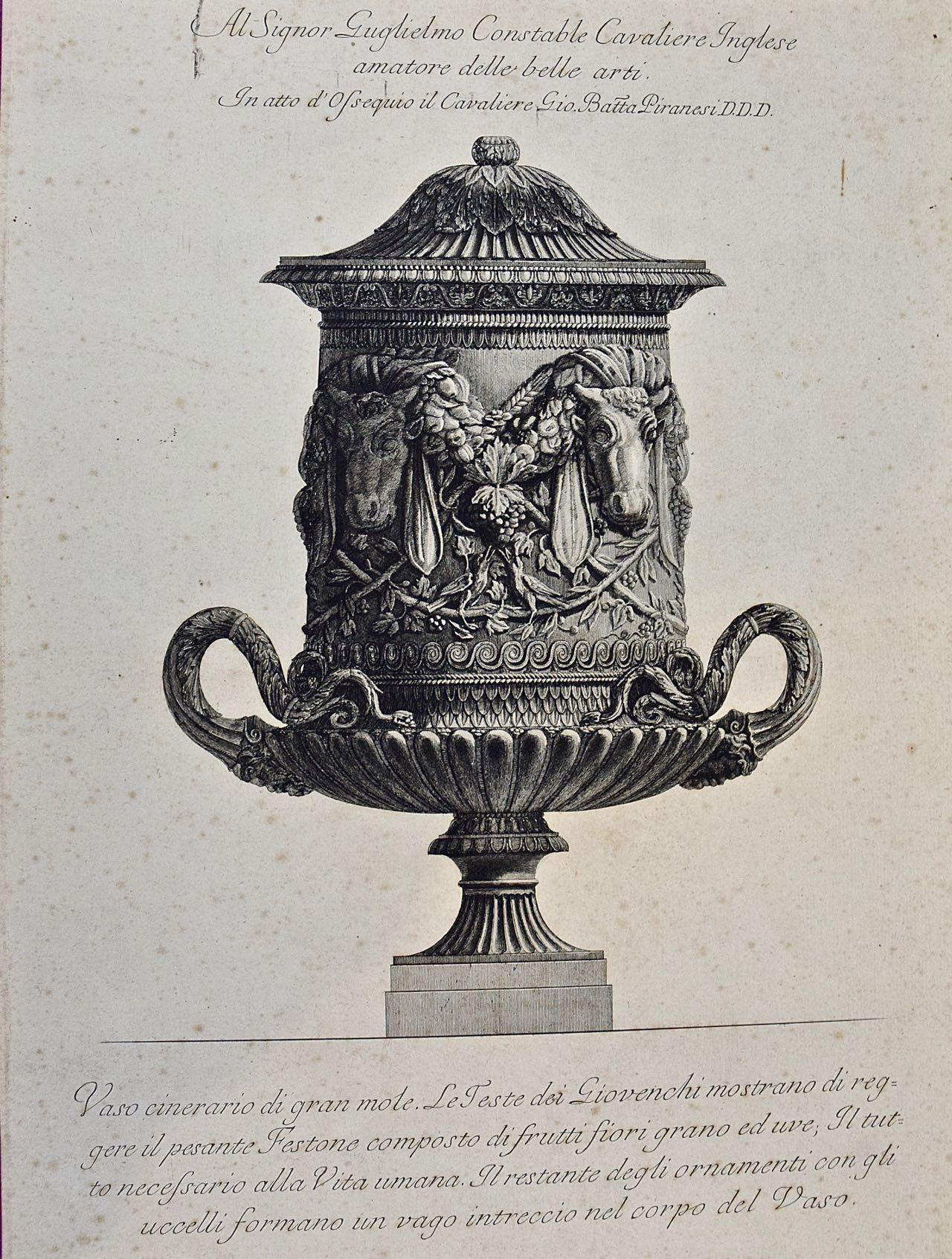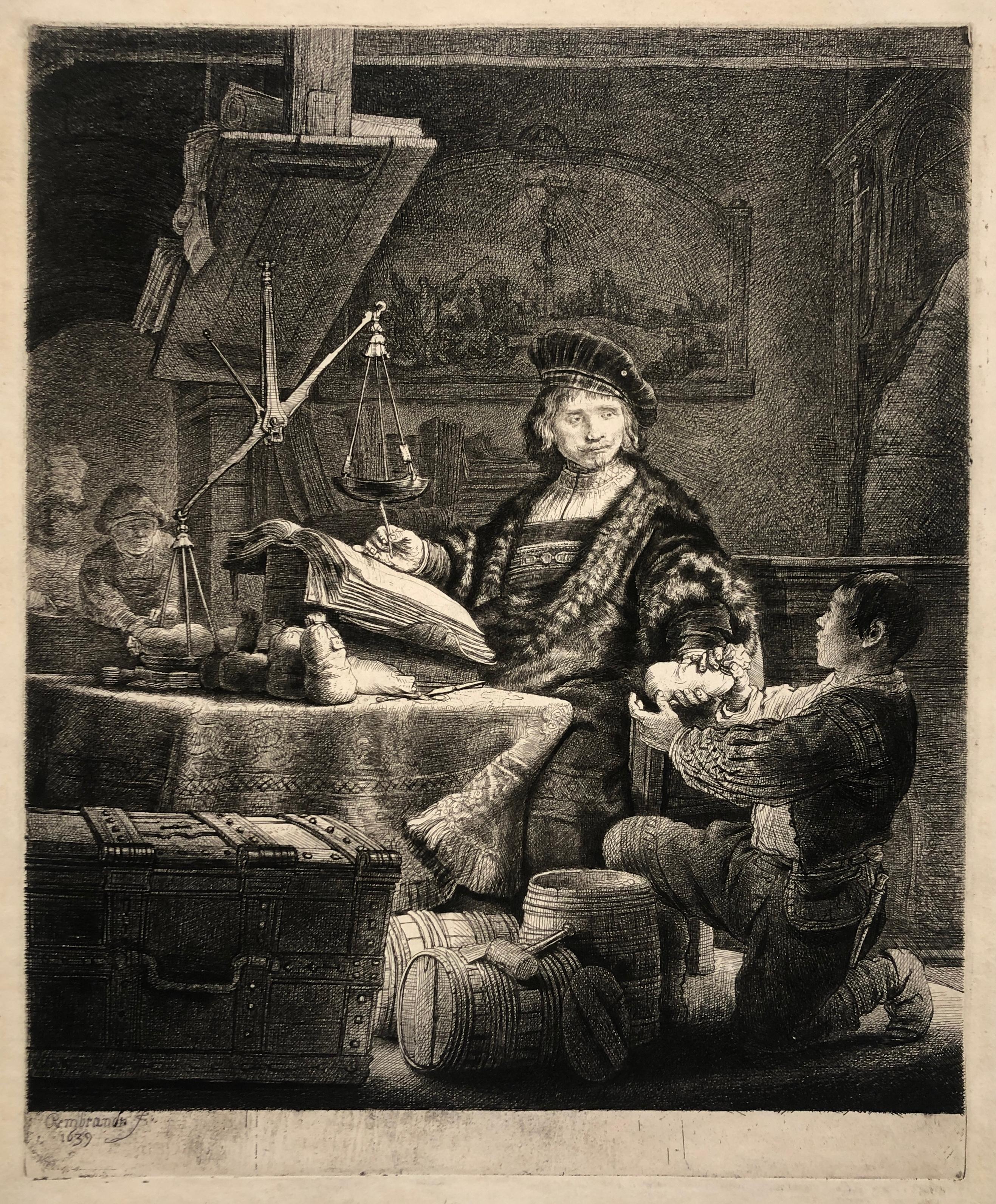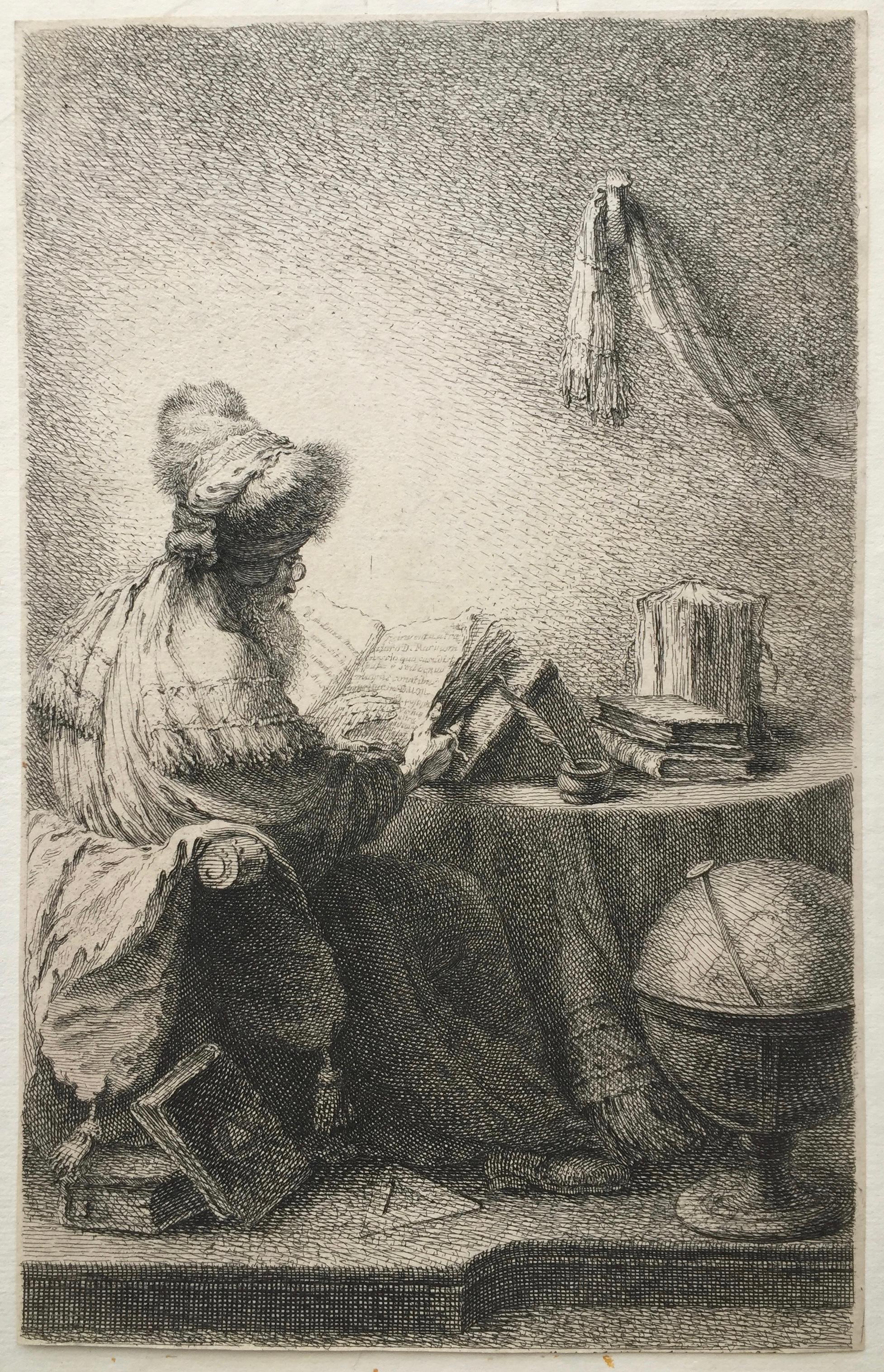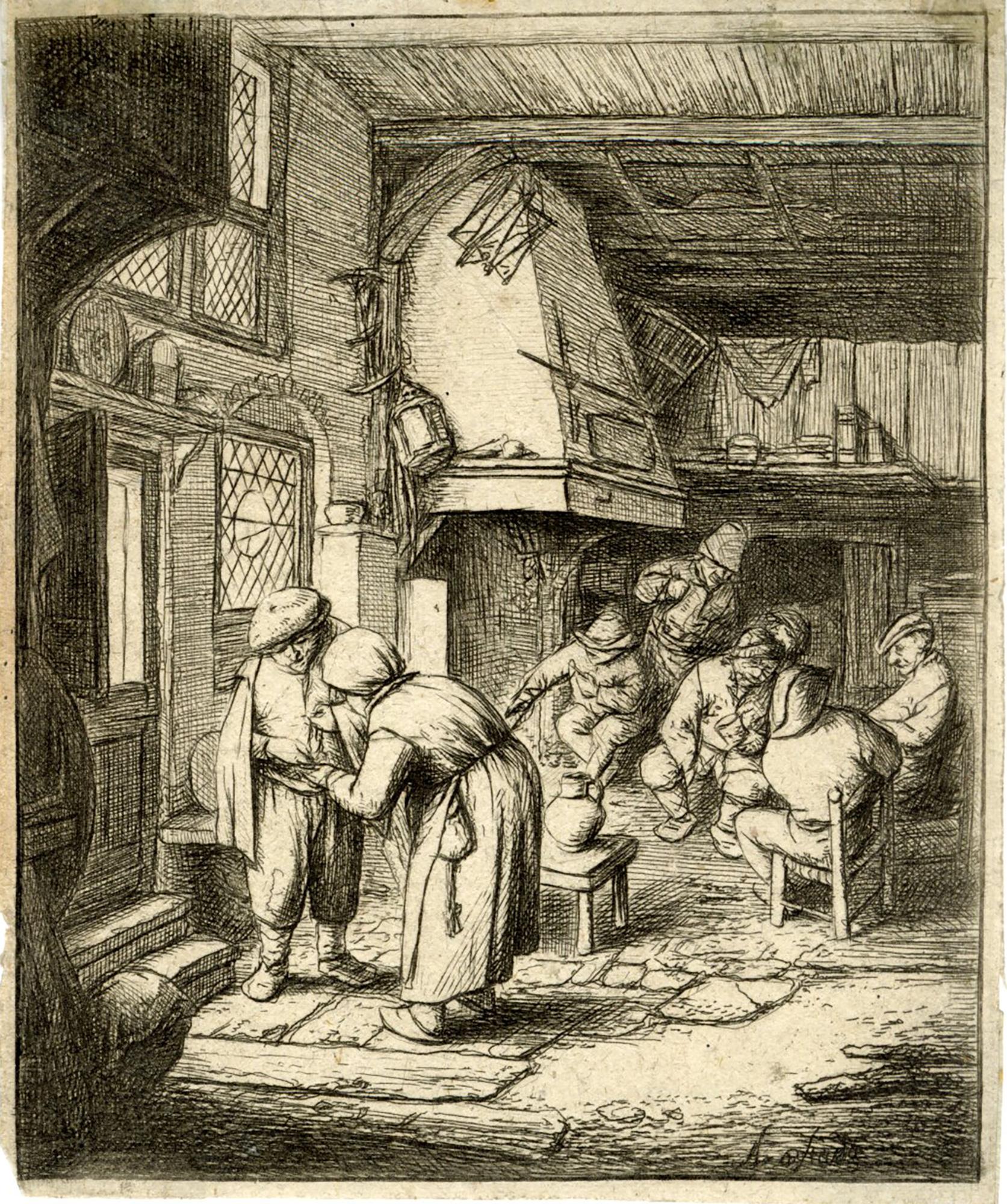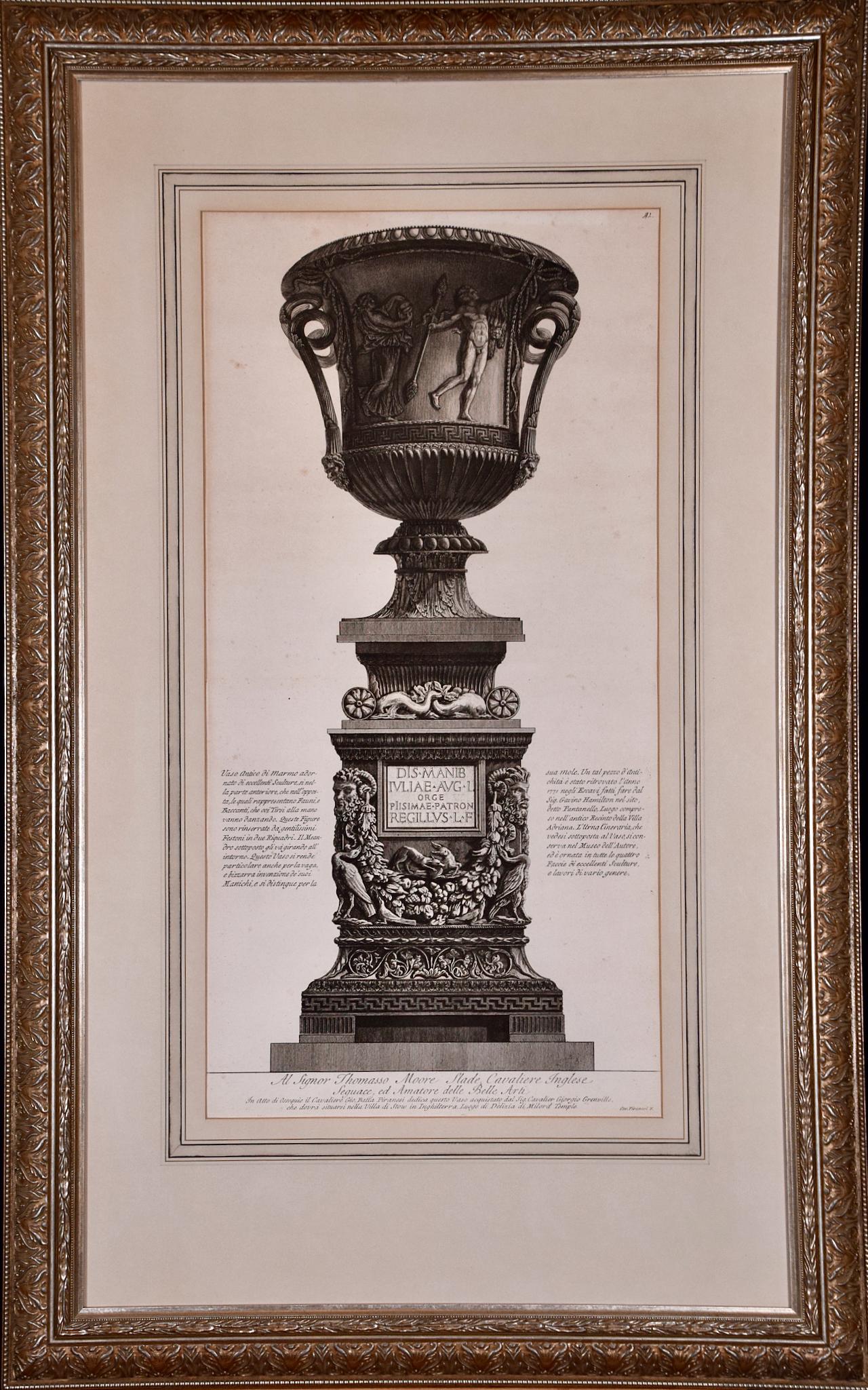Items Similar to The Roman Colosseum: A Framed 18th Century Etching of the Interior by Piranesi
Want more images or videos?
Request additional images or videos from the seller
Giovanni Battista PiranesiThe Roman Colosseum: A Framed 18th Century Etching of the Interior by Piranesi1766
1766
About the Item
This large framed 18th century etching by Giovanni Battista Piranesi entitled "Veduta dell'interno dell'Anfiteatro Flavio detto il Colosseo" (View of the interior of the Flavian Amphitheater known as the Colosseum), was published in Rome in 1766 in Piranesi's monumental work 'Vedute di Roma' (Views of Rome). This etching depicts the interior of the famous ancient Roman colosseum. The way Piranesi chose to illustrate the state of disrepair of the architecture of this wonderful and historically important ancient structure in a way reflects his concern for the decay of many of Rome's monuments and landmarks. This situation was a motivating factor for him to document the appearance of Rome's ancient architecture with his etchings, before there was further deterioration of these magnificent structures. Piranesi chose to jar our senses by selecting a perspective of the Colosseum's interior which places structures in the foreground, like the column of stone in the center and the tall overgrown structure on the right, that disrupt the pleasing symmetrical order of the small archways on the far right. The casual neglect and disrespect of the local Romans for the Colosseum is further communicated by Piranesi when he includes scenes of animals grazing within the building, fallen blocks of stone laying on the ground and vegetation growing out of portions of the structure. People, some ordinary Romans and others possibly tourists on the Grand Tour, wander about the grounds. Some of these individuals are in casual conversation, like the two men adjacent to the stone slab in the lower left, which contains the title of the piece, one leaning against the structure. The peaceful scene is in sharp contrast to the earlier violent battles of the gladiators in this very same spot. Piranesi's name appears in the lower margin on the right.
This Piranesi etching is held by many museums and institutions, including: The Metropolitan Museum, The British Museum, The National Gallery of Art, The Harvard Museum of Art, and The Portland Art Museum.
This magnificent etching is printed on heavy laid, chain-linked, deckle edge paper. It is presented in a brown-colored wood frame and a gray mat. It is glazed with UV conservation glass. All mounting materials used are archival. The frame measures 28.88" high by 37.25" wide by 1.25" deep. There is a central vertical fold, as issued. The print is in very good condition.
Piranesi began collecting, restoring and selling ancient architectural objects in the 1760's in partnership with Thomas Jenkins and Gavin Hamilton, who had financed numerous excavations in the Pantanello area of Hadrian’s Villa at Tivoli. In 1768 Piranesi began creating etchings depicting these objects. The plates were eventually published together as a set in 1778 in "Vasi, Candelabri, Cippi, Sarcofagi, Tripodi, Lucerne ed Ornamenti Antichi". Piranesi dedicated many of the plates to patrons, colleagues, good customers and influential people. Many of the antiquities shown in Vasi were eventually sold to King Gustav III of Sweden by Piranesi's son, Francesco Piranesi, after his father’s death, and now reside in the National Museum in Stockholm.
Piranesi was born in Venice in 1720 and died in Rome in 1778. He was the son of a stone mason and was trained as an architect. After a slow start he eventually achieved great success as an architect, archaeologist, artist, designer, collector, and antiquities dealer. His mission was to glorify the architecture of ancient Rome through his engravings and etchings. His highly dramatized prints often depict imaginary interiors and frequently include figures in mysterious activities, who are dwarfed by the magnitude of their monumental surroundings. Piranesi was knighted by the Pope in 1765 and he was elected a Fellow of the Society of Antiquaries in England in 1757. Piranesi's style greatly influenced the neoclassical art movement of the late 18th century. His dramatic scenes inspired generations of set designers, as well as artists, architects and writers. His prints have continued to increase in value to institutions and collectors.
References:
Wilton-Ely 1994 211
Focillon 1918 760
Hind 1922 78
- Creator:Giovanni Battista Piranesi (1720-1778, Italian)
- Creation Year:1766
- Dimensions:Height: 28.88 in (73.36 cm)Width: 37.25 in (94.62 cm)Depth: 1.25 in (3.18 cm)
- Medium:
- Movement & Style:
- Period:1760-1769
- Condition:
- Gallery Location:Alamo, CA
- Reference Number:
Giovanni Battista Piranesi
Piranesi was born in Venice in 1720 and died in Rome in 1778. He was the son of a stone mason and was trained as an architect. After a slow start he eventually achieved great success as an architect, archaeologist, artist, designer, collector, and antiquities dealer. His mission was to glorify the architecture of ancient Rome through his engravings and etchings. His highly dramatized prints often depict imaginary interiors and frequently include figures in mysterious activities, who are dwarfed by the magnitude of their monumental surroundings. Piranesi's style greatly influenced the neoclassical art movement of the late 18th century. His dramatic scenes inspired generations of set designers, as well as artists, architects and writers. His prints have continued to increase in value to institutions and collectors.
About the Seller
5.0
Vetted Seller
These experienced sellers undergo a comprehensive evaluation by our team of in-house experts.
Established in 2011
1stDibs seller since 2019
234 sales on 1stDibs
Typical response time: 1 hour
- ShippingRetrieving quote...Ships From: Alamo, CA
- Return PolicyA return for this item may be initiated within 7 days of delivery.
More From This SellerView All
- Ancient Roman Marble Vase: 18th C. Piranesi Etching Vaso Cinerario di Gran MoleBy Giovanni Battista PiranesiLocated in Alamo, CA"Vaso Cinerario di Gran Mole. Le Teste dei Giovenchi mostrano di reggere it pesante Festone composto di Frutti Fiori Grans ed use. Il tuto Necefsario all Vita Umana. Il Restante degl...Category
1760s Old Masters Figurative Prints
MaterialsEtching
- 18th Century Etching of Ancient Roman Architectural Objects by Giovanni PiranesiBy Giovanni Battista PiranesiLocated in Alamo, CAA. Tigna Protensa Super Media Epistylia, B. Praecisiones Tigorum Quaqua Versus Extrinsectus Apparentium, C. Opae Extremitates Tigorum Contintes, Fig. I, plate 88 from "Vasi, Candelab...Category
Mid-18th Century Old Masters Figurative Prints
MaterialsEtching
- A Framed 18th C. Piranesi Etching of an Ancient Marble Vase from Hadrian's VillaBy Giovanni Battista PiranesiLocated in Alamo, CAThis large framed 18th century etching by Giovanni Battista Piranesi is entitled "Vaso antico di Marmo adornato di eccellenti Sculture si nella parte anteriere che nell' opposta, le ...Category
1770s Old Masters Figurative Prints
MaterialsEtching
- Ancient Roman Medici Marble Vase: An 18th Century Etching by PiranesiBy Giovanni Battista PiranesiLocated in Alamo, CAThis large 18th century etching by Giovanni Battista Piranesi is entitled "Vaso antico di Marmo adornato di eccellenti Sculture si nella parte anteriere che nell' opposta, le quail r...Category
1770s Old Masters Figurative Prints
MaterialsEtching
- Church of St. Costanza, Rome: An 18th Century Piranesi Architectural EtchingBy Giovanni Battista PiranesiLocated in Alamo, CAThis is a framed 18th century Giovanni Battista Piranesi etching entitled: "Veduta interna del Sepocro di Santa Costanza, fabbricat...Category
1770s Old Masters Interior Prints
MaterialsEtching
- Bow Street Office: Rowlandson Hand-colored Engraving from Microcosm of LondonBy Thomas RowlandsonLocated in Alamo, CAAn early 19th century print entitled "Bow Street Office", an illustration (Plate 11) from "The Microcosm of London", published in London in 1808 by R. Acker...Category
Early 1800s Other Art Style Interior Prints
MaterialsEtching, Aquatint
You May Also Like
- Jan Uytenbogaert, The GoldweigherBy Rembrandt van RijnLocated in Boston, MABartsch 281, Hind 167 iii/III, Nowell-Usticke 281, iii/III. A fine impression, with burr, as retouched by Baillie in 1792. With an unidentified collectors stamp, verso.Category
17th Century Old Masters Figurative Prints
MaterialsDrypoint, Etching
- (PHILOSOPHER READING)By Ferdinand BolLocated in Santa Monica, CACircle of or a follower of Ferdinand Bol - (1616-1680) (PHILOSOPHER READING) ca 1700 Etching on thin laid paper attached to support sheet at the top sh...Category
18th Century Old Masters Figurative Prints
MaterialsEtching
- The Peasant Settling His DebtBy Adriaen van OstadeLocated in Middletown, NYEtching on thin, cream laid paper 4 x 3 5/8 inches (100 x 90 mm), with narrow margins, trimmed inside the platemark. Adhesive residue at the top right and left corners, and archival ...Category
17th Century Old Masters Interior Prints
MaterialsEtching
- Scène de Bistrot - Unknow Artist After Adrian Van Ostade - 18th CenturyLocated in Roma, ITImage dimensions: 15 x 12 cm. Scène de bistrot is a black and white etching with burin interventions on paper realized by an anonymous artist, after the Flemish artist Adrian Van Ostade...Category
Early 18th Century Old Masters Figurative Prints
MaterialsEtching
- The Death of the VirginBy Rembrandt van RijnLocated in San Francisco, CAA strong, dark 18th century impression of Bartsch's third and final state. Similar to that found in an impression of the same state in the collection of the Metropolitan Museum of Ar...Category
18th Century and Earlier Old Masters Interior Prints
- La Messe (The Mass), after CaravaggioLocated in Middletown, NYChiaroscuro woodcut with underlying engraving on cream laid paper, printed from two blocks in brown and olive. 10 1/4 x 12 3/4 inches (260 x 321 mm) (plate), full margins with the text printing clearly below in black ink. In very good condition with scattered surface soiling and several minor flecks of light discoloration in the margins, especially in the area of the lower right corner, well outside of image area. Unobtrusive notations in pencil in the margin and on the verso. All condition issues are consistent with age. After a drawing of the same title by Polidoro da Caravaggio...Category
Mid-18th Century Old Masters Figurative Prints
MaterialsEngraving, Laid Paper, Woodcut
Recently Viewed
View AllMore Ways To Browse
A Frame
England Roman
Roman Order
Framing Antique Documents
Foldable Glasses Frames
Framed Art Neoclassical
Used Stone Slabs
Ancient Roman Stone
18th Century Mens
Grand Tour Framed
Hamilton Of Two
18th Century Small Swedish
Neoclassical Architecture Framed
Framed Architectural Engravings
Antique Large Glass Jars
Large Antique Glass Jar
Portland Stone
Ancient Roman Column
